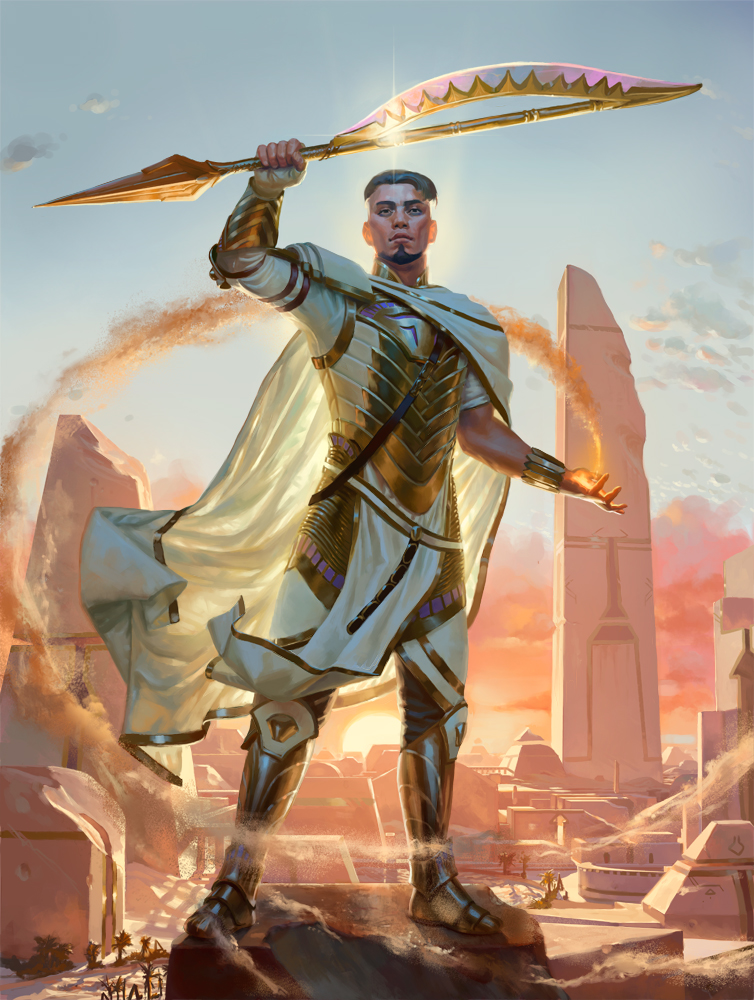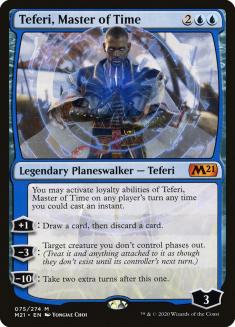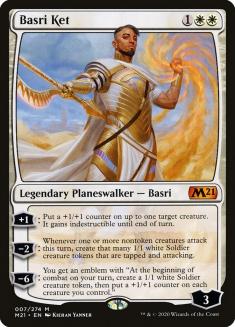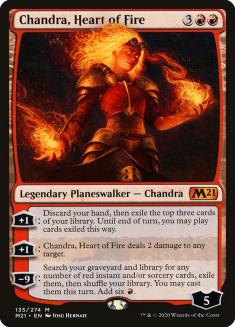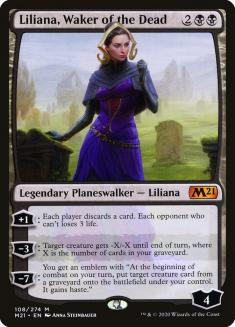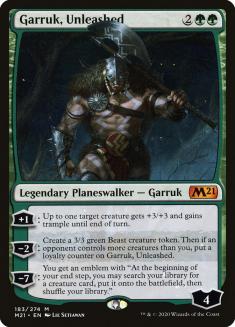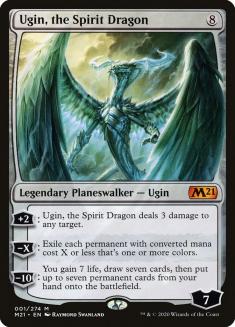We’re still jamming on preview season for Core Set 2021, and it’s shaping up to be a powerful follow-up for Commander to Ikoria: Lair of Behemoths. While Ikoria was light on planeswalkers, they’re front and center in Core Set 2021, with a new Teferi being the set’s face card. From debuts to reprints, the characters old and new we’ve seen so far are quite saucy.
Planeswalkers can be a mixed bag in Commander. While they’re undoubtedly powerful, without a dedicated strategy to protect them (such as in your Atraxa Superfriends deck), they’re difficult to keep alive. You need to protect them through three different combat steps, and players who are hesitant to do chip damage to players are happy to knock counters off your planeswalkers. The cards we tend so see are strong enough that I’ve started playing Aether Snap in a few of my black decks; the fact that it gets rid of other counters and tokens is just a bonus for the planeswalker killing.
Before anyone asks, nothing in this set (or any other recent ones) has moved the Commander Rules Committee (RC) off our stance regarding all planeswalkers as commanders. We’re fine if our friends at Wizards of the Coast design planeswalker cards that say that they can be your commander—and, as we did when the idea first came up, we will urge caution and care in said design.
Teferi, Master of Time
A card that’s likely to make a big splash in Standard, Teferi, Master of Time breaks the rules of planeswalkers by letting you activate it on everyone else’s turns. Getting to ten loyalty on a normal planeswalker is pretty difficult without quite a few proliferate shenanigans. This Teferi accelerates that schedule quite a bit.
The +1 ability to loot gets better when you use it to fill your graveyard in addition to sculpting your hand. Whether you’re playing some kind of reanimation with black or flashback with other colors, particularly red and your native blue, you get your pick of what to use from two different zones.
The -3 ability highlights the reintroduction of phasing into the game. It’s come a long way from Fog Elemental plus Teferi’s Veil. What’s better about phasing than blinking is that everything stays on the creature—most importantly, counters and enchantments. Players who haven’t seen phasing before will find a new strategic avenue opened up to them. And maybe a few Star Trek episodes wills start making a little more sense.
Once you manage to activate the -10 ability, the game should be yours. Casting a Time Stretch (which can’t be the target of Deflecting Swat) that doesn’t cost ten mana means you still have plenty of action on the current turn. I count that as a finishing move.
Like Jace, the Mind Sculptor, Teferi, Master of Time slots into nearly any blue deck, regardless of theme. It’s a single-card strategy that you can leverage to nearly any end. My preference would be the aforementioned reanimation theme, taking full advantage of the +1 ability to craft exactly the graveyard I want to Regrow.
Note that as the face of the set, this Teferi comes in like 16 different forms—alternate art, framings, foiling—all of which are likely to get the collectors very excited.
Teferi, Timeless Voyager

The Master of Time isn’t the only Teferi in the set! Teferi, Timeless Voyager is more expensive to cast and a little less scary for your opponents. That fact doesn’t undermine its utility.
The +1 ability is pretty simple—it draws you a card. No arguments about whether this is party Jace or not.
The -3 ability is more compelling than it seems on the surface. It’s not just getting rid of a big threat. It does at least two more things. One, it costs the player a draw by making the targeted card the next thing they’ll get. Two, which becomes more evident in the time when phasing is back, it gets rid of any buffs to the creature, such as counters or enchantments. In a format in which mutate has already become a popular mechanic, it’s costing them more than one draw, since it’ll put the whole stack back on top. Unless the creature has haste when they recast it, you’ve messed up their turn timing by getting rid of something (albeit temporarily) that could be smashing into Teferi in the first place.
Don’t underestimate the value of using the -3 ability as a political tool, either. You could make friends by sending off Hushwing Gryff for a short period of time, or simply giving someone another trigger off their Mulldrifter.
The “can’t phase back in” clause is the first thing I focused on when looking at the -8 ability. If there are cards that phase things back in, this ability would stop them (remember, in Magic, when can and can’t argue, can’t always wins). The ability will both open the way for you to attack, and assuming they’re still alive, keep you from the crack-backs. It’s not uber-powerful as planeswalker ultimates go, but it’ll get there.
Basri Ket
The new character in the Core Set 2021 storyline is Basri Ket. You can check out Creative Director Liz Leo’s rundown on the character here on the mothership. And while we Vorthos types love the lore, we’re here to talk about the card’s gameplay.
The low mana cost lets you bring it out early, but the low loyalty makes it more fragile. While you can activate the +1 ability without having a creature, it makes more sense when you do. Indestructible is a good ability to have when you’re slamming a creature into combat and the +1/+1 counter stays around for more beatings later. Alternately, that counter wipes out a -1/-1 counter, which is super-important if the creature has persist.
The single word nontoken keeps the -2 ability from being crazy. Still, doubling up the number of attackers can be scary, especially when you have cards like Cathars’ Crusade going. Putting a bunch of creatures onto the battlefield already attacking can be life-damaging, even if they’re 1/1s. It’s a little unfortunate that they’ll see it coming, but sometimes there’s not really much they can do about it.
I was initially on the fence about the -6 ability, but then came around when I realized it’s an emblem. That means it’ll keep happening—plus, you can get more than one. It’s a nice build from the -2—get a bunch of 1/1s, then on subsequent turns, keep making them larger.
Basri, Devoted Paladin

The second version of Basri has a little bit of the feel of OG Elspeth, Knight-Errant. It quickly diverges, but I couldn’t shake the impression. The +1 ability is fine, but it’s mostly there to get you to the higher number or be able to use the -1 ability more times.
The -1 ability can get a little sick when you have a large team. Follow up Storm Herd with a Basri activation and you’re dealing some damage. There are six cards that give trample to all your creatures with +1/+1 counters on them: Bramblewood Paragon; Crowned Ceratok; Trollbred Guardian; Tuskguard Captain; Zegana, Utopian Speaker; and Core Set 2021’s Pridemalkin. They’re all green (and Zegana is Simic), so you’ll have to branch out into one or more colors, but they happen to have some pretty saucy creatures, so you’ll probably be okay.
The -6 ability is fine and all, about on par with what I’d expect from a relatively inexpensive ultimate ability. +2/+2 isn’t +3/+3 and flying isn’t trample, but you’re also not spending 2GGG for it.
Chandra, Heart of Fire
This isn’t my favorite Chandra planeswalker, but I can’t call it terrible. It definitely has its uses. Unless you really want to discard your hand (like the aforementioned Reanimator strategy), you’ll still need some mana to get full value out of the first +1 ability. You’re likely to get one land drop and two spells, which isn’t as good early in the game as it is later.
The second +1 ability doesn’t do nearly as much in Commander as it might in other formats. It simply provides the march towards the ultimate goal.
The -9 searches up a particular thing or things and then gives you (some of) the mana to cast it/them. This feels like a very combo-centric card. Six red is no joke, so you could definitely grab and cast Jokulhaups. By the time you activate this ability, you’ll probably have plenty of mana (plus six), so the sky is truly the limit.
Chandra, Flame’s Catalyst

The more expensive Chandra is the exciting one. Since it enters the battlefield with five loyalty counters, you can activate the -2 ability twice without having to plus it up—a nice feature in a card that will likely be featured in decks that like to do lots of stuff.
The +1 ability does what Chandra does—fire to the face. There really isn’t much more to be said.
The thing that caught my eye on the -2 ability is the last sentence. If it would be put into your graveyard, exile it. Just the graveyard, not the hand—a choice you don’t have with flashback, for example. It’s a small thing, and there aren’t too many playable cards that it affects, Reiterate and Shattering Pulse being the two that come to mind. Knowing that I’m playing Chandra, Flame’s Catalyst might lead me to playing Reiterate earlier and without buyback than I otherwise might.
The -8 ability is, no pun intended, pure fire. It’s good enough to cast the seven for nothing. If there’s a single wheel or piece of card draw in there, you’re really off to the races and should make some people dead in short order. Dualcaster Mage is definitely a thing. I can imagine that there will be some Omniscience-like action on resolution of this Chandra’s ability.
Liliana, Waker of the Dead
It wouldn’t be a core set without a cool Liliana, and this one doesn’t disappoint. For me, this one is all about the emblem. The +1 ability is okay, although I’m always a little wary in this format about helping people put things into their graveyards. The number of players who aren’t running recursion or reanimation is low, so I want to pick and choose the spots where I have folks discard.
Given my love for thicc graveyards, the -3 ability is always going to be able to kill something. Giving minuses to toughness is one of the ways to get rid of Avacyn, Angel of Hope or other indestructible creatures. In general, I’m not using this ability unless it’s necessary because I really want to get to that emblem.
Haste kills people. It messes with combat math, and it gives you surprise attacks. Black isn’t particularly good at giving haste, so this is a super bonus. The fact that our new Liliana can get a creature from any graveyard is insanely good. My Puppeteer Clique, your Puppeteer Clique—it doesn’t matter. I’m already in love with Liliana, and this version doesn’t dampen that fire.
Liliana, Death Mage

Expensive Liliana stokes the flames a little. You have to jump through a few more hoops in order to make her really worthwhile. It’s suited to some sort of control deck where you sacrifice your creatures to destroy others or something with huge mill effects (like Traumatize) in order to use the ultimate ability as a closer. I’d be hard-pressed to use the -3 ability in a non-emergency situation. As painful as it is to say, this might be the weakest of all the Liliana planeswalkers.
Garruk, Savage Herald

The first Garruk we saw starts big and gets to its ultimate quickly. In a heavy creature deck or one with top of the library manipulation (Congregation at Dawn, maybe?), the +1 ability is effective card draw. The -2 is a one-sided fight, so you don’t have to worry about the other creature dealing damage back. A deathtouch creature, like Acidic Slime, will kill nearly anything. As seems to be the arc for the planeswalkers in this set, the ultimate is a finishing move. You don’t need trample if creatures can’t block.
Garruk, Unleashed
The second Garruk is all that and a supersized bag of chips. The abilities are all relevant and can be so at nearly any stage of the game.
The single-creature Overrun of the +1 ability can be relevant as a finisher, especially in getting through the last bit of commander damage. It’s nice early if you have something that you need to get through in order to get a trigger, but its deadliest use will be late-game.
The -2 ability, especially in a multiplayer game, is almost always going to end up as a -1. It will fit better in a black deck with lots of creature sacrifice outlets, but if you’re not getting the loyalty counter back, you’re probably in pretty good shape anyway.
The -7 is ghost pepper hot sauce. It’s at the end step, so there aren’t Craterhoof Behemoth shenanigans, but there are plenty of other options. From something simple like Pelakka Wurm to a little more play, like Stalking Vengeance, you can rather easily protect your battlefield position. If you have a one piece of a two-creature combo already on the battlefield, then you’re right where you want to be. I definitely look forward to playing this card.
Ugin, the Spirit Dragon
The best part of this reprint is the fact that the price of the original has gotten quite high. The sweet alternate art versions from Core Set 2021 will also be fetching top dollar, and I’m a fan of this direction of making premium versions available. You don’t need to shell out huge dollars to play the card—but there’s a place for you to spend your disposable income if you want to. Making the alternate versions should drive down the price of the normal one, providing everyone the opportunity to play the card without breaking their budget.
Planeswalkers are now the undisputed the faces of Magic. Core Set 2021 sets the bar high for them and then leaps right over it. As the preview season continues, we look forward seeing what the cards that jump up with them will bring.
Visit my Decklist Database to see my Signature Decks, the Chromatic Project, and more!

